Risky Banking Turns Japanese
With a tip from a Grant’s Interest Rate Observer Podcast entitled “Big, Dumb Japanese Banks,” we learn where the next financial crisis may occur. It turns out these banks coasted through the 2008 dollar-squeeze-created crisis and have since loaded up on U.S. dollar assets. The Nikkei Asian Review reports, “Japanese banks are pursuing a dangerous strategy of loading up on foreign assets with money borrowed from overseas, a global banking watchdog has warned.”
This is understandable given the current yield for a 2-year Japanese government bond yield is a negative 13 basis points. An investor has to go out 10 years to earn 7 basis points.
The problem is Japanese customers do not deposit dollars, so to buy dollar-denominated assets Japanese banks must borrow in dollars typically on a short-term basis.
Thus, the perils facing all bankers -- borrowing short to lend long.
“The reliance on short-term dollar funding raises rollover risks,” writes Mitsuru Obe, Nikkei staff writer. “Securing dollar funding may become difficult if a credit crunch hits the market, like the one in 2008.”
The Bank of International Settlements says, "Global U.S. dollar funding markets are likely to be a key pressure point during any future market stress episode. Non-U.S. entities' U.S. dollar funding needs remain large, posing potentially sizable rollover risks."
According to the Bank of Japan, Japanese banks' net foreign assets hit an all-time high at the end of March of $2.27 trillion, with net dollar holdings doubling since the Lehman Brothers failure. At the same time, “Having suffered severe dollar shortages during the Lehman crisis, German banks have moved to cut their exposure to dollar assets, to zero from around $200 billion in 2007, according to the BIS.”
Perhaps the Japanese banks can take comfort in Janet Yellen’s pronouncement that financial crisis have been put on hold for the rest of her lifetime.






